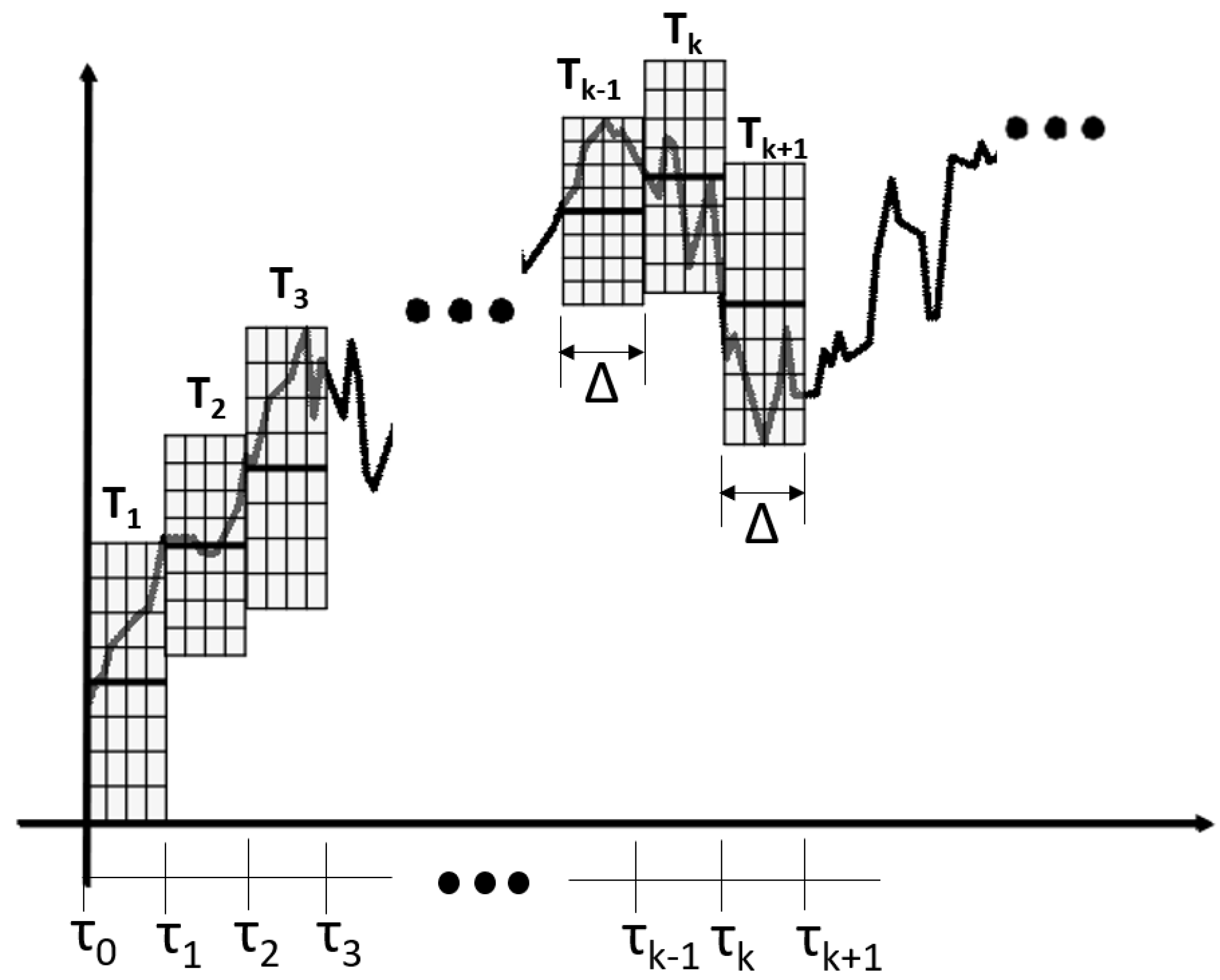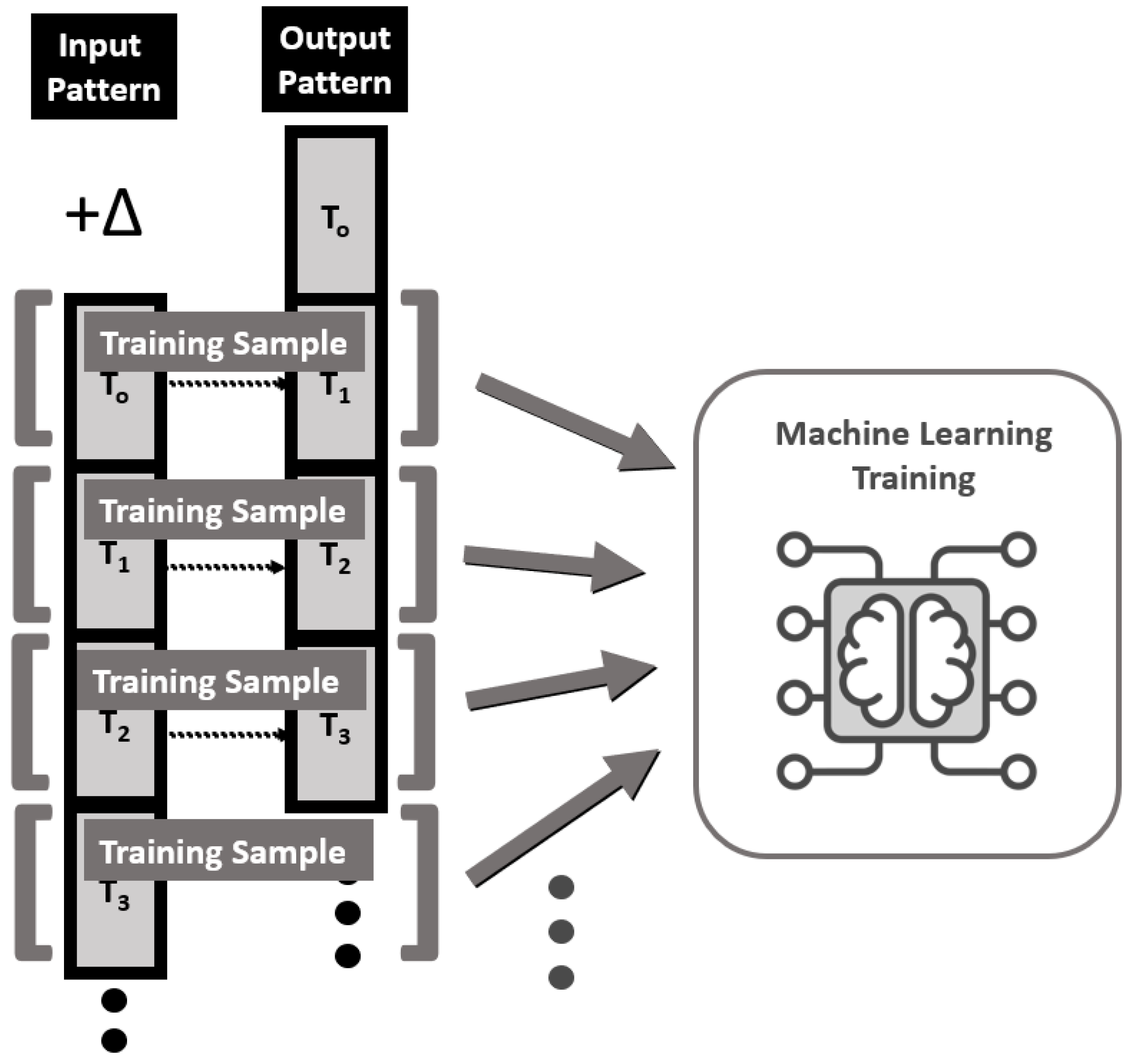Linear Algebraic Approach for Delayed Patternized Time-Series Forecasting Models
Abstract
1. Introduction
2. Linear Algebraic Approach for Time Series
3. Delayed Patternized Time-Series Machine Learning Training
4. Conclusions
Funding
Data Availability Statement
Acknowledgments
Conflicts of Interest
References
- Sewell, M. History of the efficient market hypothesis. Rn 2011, 11, 04. [Google Scholar]
- Malkiel, B.G. Efficient Market Hypothesis; Springer: Berlin/Heidelberg, Germany, 1989; pp. 127–134. [Google Scholar]
- Maharani, F.A.; Ivana, S.; Fithriyah, B.; Zakiyyah, A.Y.; Sihotang, E.F.A. Time Series Forecasting Using LSTM to Predict Stock Market Price in the First Quarter of 2024. In Proceedings of the 2024 International Conference on Smart Computing, IoT and Machine Learning (SIML), Surakarta, Indonesia, 6–7 June 2024; pp. 74–80. [Google Scholar]
- Shah, H.; Bhatt, V.; Shah, J. A Neoteric Technique Using ARIMA-LSTM for Time Series Analysis on Stock Market Forecasting. In Mathematical Modeling, Computational Intelligence Techniques and Renewable Energy; Sahni, M., Merigó, J.M., Sahni, R., Verma, R., Eds.; Springer Nature: Singapore, 2022; pp. 381–392. [Google Scholar]
- Ma, Q. Comparison of ARIMA, ANN and LSTM for Stock Price Prediction. In Proceedings of the 2020 International Symposium on Energy, Environmental Science and Engineering (ISEESE 2020), Chongqing, China, 20–22 November 2020. 5p. [Google Scholar]
- Zhang, L.; Zhao, M.; Feng, Z. Research on knowledge discovery and stock forecasting of financial news based on domain ontology. Int. J. Inf. Technol. Decis. Mak. 2019, 18, 953–979. [Google Scholar] [CrossRef]
- Mintarya, L.N.; Halim, J.N.; Angie, C.; Achmad, S.; Kurniawan, A. Machine learning approaches in stock market prediction: A systematic literature review. Procedia Comput. Sci. 2023, 216, 96–102. [Google Scholar] [CrossRef]
- Htun, H.H.; Biehl, M.; Petkov, N. Forecasting relative returns for S&P 500 stocks using machine learning. Financ. Innov. 2024, 10, 118. [Google Scholar]
- Zheng, J.; Xin, D.; Cheng, Q.; Tian, M.; Yang, L. The Random Forest Model for Analyzing and Forecasting the US Stock Market in the Context of Smart Finance. arXiv 2024, arXiv:2402.17194. [Google Scholar]
- Wang, C.; Chen, Y.; Zhang, S.; Zhang, Q. Stock market index prediction using deep Transformer model. Expert Syst. Appl. 2022, 208, 118128. [Google Scholar] [CrossRef]
- Tao, Z.; Wu, W.; Wang, J. Series decomposition Transformer with period-correlation for stock market index prediction. Expert Syst. Appl. 2024, 237, 121424. [Google Scholar] [CrossRef]
- Rabanser, S.; Januschowski, T.; Flunkert, V.; Salinas, D.; Gasthaus, J. The Effectiveness of Discretization in Forecasting: An Empirical Study on Neural Time Series Models. arXiv 2005, arXiv:2005.10111. [Google Scholar]
- Chang, J.R.; Liu, C.C. A fuzzy time series model based on N-th Quantile Discretization Approach for TAIEX forecasting. In Proceedings of the 2013 5th International Conference on Knowledge and Smart Technology (KST), Chonburi, Thailand, 31 January–1 February 2013; pp. 5–10. [Google Scholar]
- Changqing, Z.; Chengzhi, L. Research on Railway Passenger Traffic Volume Forecasting Method. In Proceedings of the 2009 International Forum on Information Technology and Applications, Chengdu, China, 15–17 May 2009; Volume 1, pp. 279–282. [Google Scholar]
- Kim, S.K. Kelly Criterion Extension: Advanced Gambling Strategy. Mathematics 2024, 12, 1725. [Google Scholar] [CrossRef]
- Zhan, Z.; Kim, S.K. Novel Delayed Binary Time-Series Pattern Based Machine Learning Techniques for Stock Market Forecasting. 2025; submitted. [Google Scholar]
- Tutorials, E. Exclusive-NOR Gate Tutorial. 2020. Available online: https://www.electronics-tutorials.ws/logic/logic_8.html (accessed on 31 January 2025).
- Shalev-Shwartz, S.; Ben-David, S. Understanding Machine Learning; Cambridge University Press: Navi Mumbai, India, 2014. [Google Scholar]
- Afriyie, J.K.; Tawiah, K.; Pels, W.A.; Addai-Henne, S.; Dwamena, H.A.; Owiredu, E.O.; Ayeh, S.A.; Eshun, J. A supervised machine learning algorithm for detecting and predicting fraud in credit card transactions. Decis. Anal. J. 2023, 6, 100163. [Google Scholar] [CrossRef]
- Vijh, A.M. S&P 500 Trading Strategies and Stock Betas. Rev. Financ. Stud. 1994, 7, 215–251. [Google Scholar]



Disclaimer/Publisher’s Note: The statements, opinions and data contained in all publications are solely those of the individual author(s) and contributor(s) and not of MDPI and/or the editor(s). MDPI and/or the editor(s) disclaim responsibility for any injury to people or property resulting from any ideas, methods, instructions or products referred to in the content. |
© 2025 by the author. Licensee MDPI, Basel, Switzerland. This article is an open access article distributed under the terms and conditions of the Creative Commons Attribution (CC BY) license (https://creativecommons.org/licenses/by/4.0/).
Share and Cite
Kim, S.-K. Linear Algebraic Approach for Delayed Patternized Time-Series Forecasting Models. Axioms 2025, 14, 224. https://doi.org/10.3390/axioms14030224
Kim S-K. Linear Algebraic Approach for Delayed Patternized Time-Series Forecasting Models. Axioms. 2025; 14(3):224. https://doi.org/10.3390/axioms14030224
Chicago/Turabian StyleKim, Song-Kyoo. 2025. "Linear Algebraic Approach for Delayed Patternized Time-Series Forecasting Models" Axioms 14, no. 3: 224. https://doi.org/10.3390/axioms14030224
APA StyleKim, S.-K. (2025). Linear Algebraic Approach for Delayed Patternized Time-Series Forecasting Models. Axioms, 14(3), 224. https://doi.org/10.3390/axioms14030224





